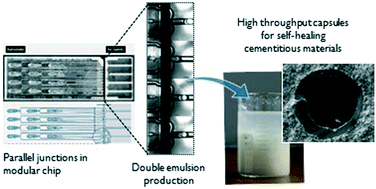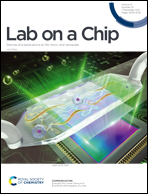High throughput production of microcapsules using microfluidics for self-healing of cementitious materials
Abstract
Capsule-based self-healing of cementitious materials is an effective way of healing cracks, significantly extending the life of structures, without imposing changes due to the incorporation of capsules into products during mixing. The methodologies currently being used for the development of capsules with a liquid core as a healing agent yield a wide range of sizes and shell thicknesses for the microcapsules, preventing a detailed assessment and optimisation of the microcapsule size and its effects. Uniquely, microfluidic technology offers precise control over the size and shell thickness through the formation of double emulsions. The drawback is that only small quantities of material can be typically produced. Here, by using paralleled junctions in a microfluidic device, high throughput production of materials was achieved, focusing for the first time on self-healing of cementitious materials. A microfluidic chip was assembled with 4 channels in parallel and selected hydrophobicity for the formation of the double emulsions. A coefficient of variation below 2.5% was observed for the 4 junctions, demonstrating the formation of monodisperse capsules. The control over the size and shell thickness by adjusting the flow rates was demonstrated, yielding capsules with an outer diameter of 615–630 μm and a shell thickness varying between 50 and 127 μm. By using triethanolamine as a surfactant, capsules with an aqueous core were produced. Furthermore, by selecting PEA, an acrylate with low tensile strength, the capsules embedded in the cement paste were successfully triggered to release the healing agent by crack formation. Capsules were successfully produced continuously for 7 h, with inner and outer diameters of 500 ± 31 μm and 656 ± 9 μm at a production rate of ∼13 g h−1 and a yield of around 80%. With these results and considering up to 6 chips in parallel, the production rate could be up to 1.5 kg per day. This demonstrates the huge potential of the microfluidic device with unique features to produce sufficiently large quantities of microcapsules for laboratory-scale assessment of self-healing performance.



 Please wait while we load your content...
Please wait while we load your content...